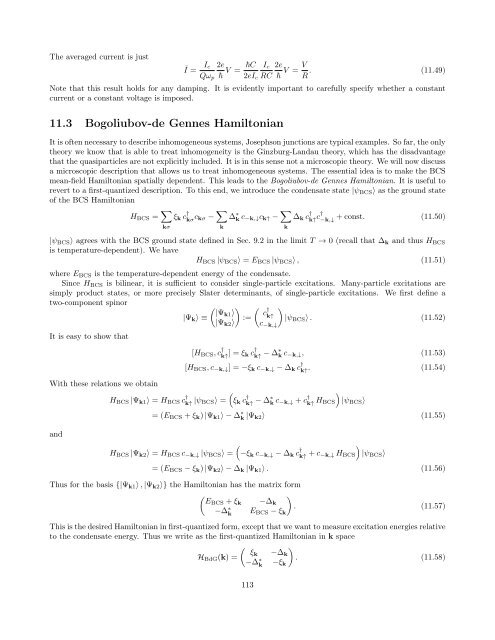Carsten Timm: Theory of superconductivity
Carsten Timm: Theory of superconductivity
Carsten Timm: Theory of superconductivity
You also want an ePaper? Increase the reach of your titles
YUMPU automatically turns print PDFs into web optimized ePapers that Google loves.
The averaged current is just<br />
Ī =<br />
I c 2e<br />
Qω p V = C I c 2e<br />
2eI c RC V = V R . (11.49)<br />
Note that this result holds for any damping. It is evidently important to carefully specify whether a constant<br />
current or a constant voltage is imposed.<br />
11.3 Bogoliubov-de Gennes Hamiltonian<br />
It is <strong>of</strong>ten necessary to describe inhomogeneous systems, Josephson junctions are typical examples. So far, the only<br />
theory we know that is able to treat inhomogeneity is the Ginzburg-Landau theory, which has the disadvantage<br />
that the quasiparticles are not explicitly included. It is in this sense not a microscopic theory. We will now discuss<br />
a microscopic description that allows us to treat inhomogeneous systems. The essential idea is to make the BCS<br />
mean-field Hamiltonian spatially dependent. This leads to the Bogoliubov-de Gennes Hamiltonian. It is useful to<br />
revert to a first-quantized description. To this end, we introduce the condensate state |ψ BCS ⟩ as the ground state<br />
<strong>of</strong> the BCS Hamiltonian<br />
H BCS = ∑ kσ<br />
ξ k c † kσ c kσ − ∑ k<br />
∆ ∗ k c −k,↓ c k↑ − ∑ k<br />
∆ k c † k↑ c† −k,↓<br />
+ const. (11.50)<br />
|ψ BCS ⟩ agrees with the BCS ground state defined in Sec. 9.2 in the limit T → 0 (recall that ∆ k and thus H BCS<br />
is temperature-dependent). We have<br />
H BCS |ψ BCS ⟩ = E BCS |ψ BCS ⟩ , (11.51)<br />
where E BCS is the temperature-dependent energy <strong>of</strong> the condensate.<br />
Since H BCS is bilinear, it is sufficient to consider single-particle excitations. Many-particle excitations are<br />
simply product states, or more precisely Slater determinants, <strong>of</strong> single-particle excitations. We first define a<br />
two-component spinor<br />
( ) (<br />
|Ψk1 ⟩ c<br />
†<br />
)<br />
|Ψ k ⟩ ≡ :=<br />
k↑<br />
|ψ<br />
|Ψ k2 ⟩<br />
BCS ⟩ . (11.52)<br />
c −k,↓<br />
It is easy to show that<br />
With these relations we obtain<br />
H BCS |Ψ k1 ⟩ = H BCS c † k↑ |ψ BCS⟩ =<br />
[H BCS , c † k↑ ] = ξ k c † k↑ − ∆∗ k c −k,↓ , (11.53)<br />
[H BCS , c −k,↓ ] = −ξ k c −k,↓ − ∆ k c † k↑ . (11.54)<br />
(<br />
)<br />
ξ k c † k↑ − ∆∗ k c −k,↓ + c † k↑ H BCS |ψ BCS ⟩<br />
= (E BCS + ξ k ) |Ψ k1 ⟩ − ∆ ∗ k |Ψ k2 ⟩ (11.55)<br />
and<br />
H BCS |Ψ k2 ⟩ = H BCS c −k,↓ |ψ BCS ⟩ =<br />
(−ξ k c −k,↓ − ∆ k c † k↑ + c −k,↓ H BCS<br />
)<br />
|ψ BCS ⟩<br />
= (E BCS − ξ k ) |Ψ k2 ⟩ − ∆ k |Ψ k1 ⟩ . (11.56)<br />
Thus for the basis {|Ψ k1 ⟩ , |Ψ k2 ⟩} the Hamiltonian has the matrix form<br />
(<br />
EBCS + ξ k −∆ k<br />
−∆ ∗ k<br />
E BCS − ξ k<br />
)<br />
. (11.57)<br />
This is the desired Hamiltonian in first-quantized form, except that we want to measure excitation energies relative<br />
to the condensate energy. Thus we write as the first-quantized Hamiltonian in k space<br />
( )<br />
ξk −∆<br />
H BdG (k) =<br />
k<br />
−∆ ∗ . (11.58)<br />
k<br />
−ξ k<br />
113

















